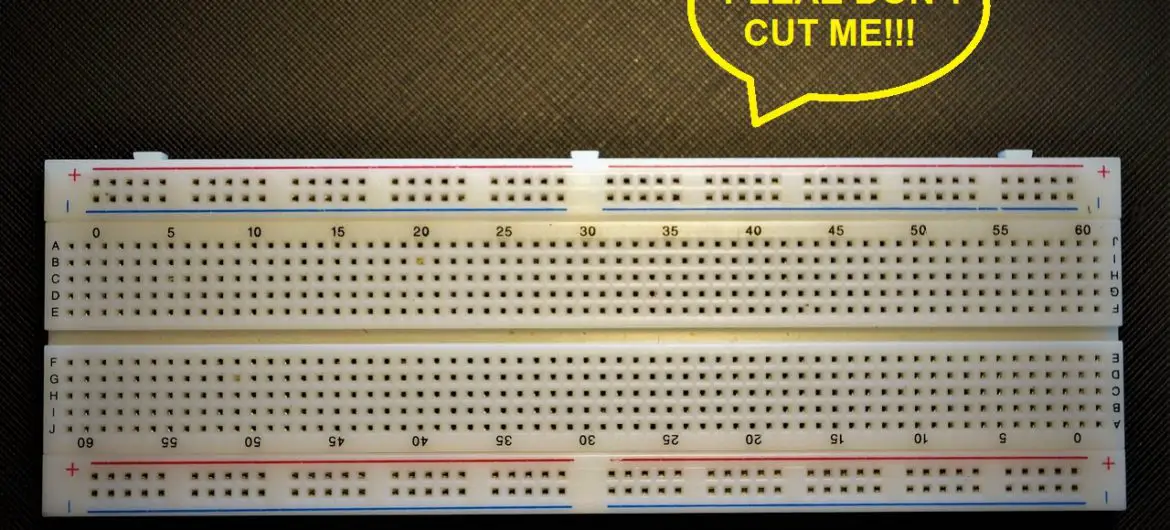Breadboards (or solderless breadboards) are a great tool to use in the prototyping phase of a project.
You can easily set up and test circuits without having to go through the process of soldering and desoldering.
They are great not just for beginners, but experts who are trialling and testing new ideas.
But, can we cut a breadboard?
No, you should not cut a breadboard as it is not ideal. Cutting a breadboard will ruin its structural integrity rendering it useless. Breadboards consist of rows and columns of conducting strips where component leads can be connected. Cutting the breadboard will ruin these strips and disrupt its continuity.
This article shall dive deeper into why it is not ideal to cut a breadboard.
However, in saying that it is not ideal to cut a breadboard, if you really have to cut one, I shall discuss what is the best way to do so.
Why it is not advisable to cut a traditional breadboard
To better understand why it is not the best idea to cut a breadboard, let’s take a closer at the breadboard’s internal construction.
A closer look of the breadboard
The beauty of the breadboard is that you can set up and test a circuit without having to solder anything.
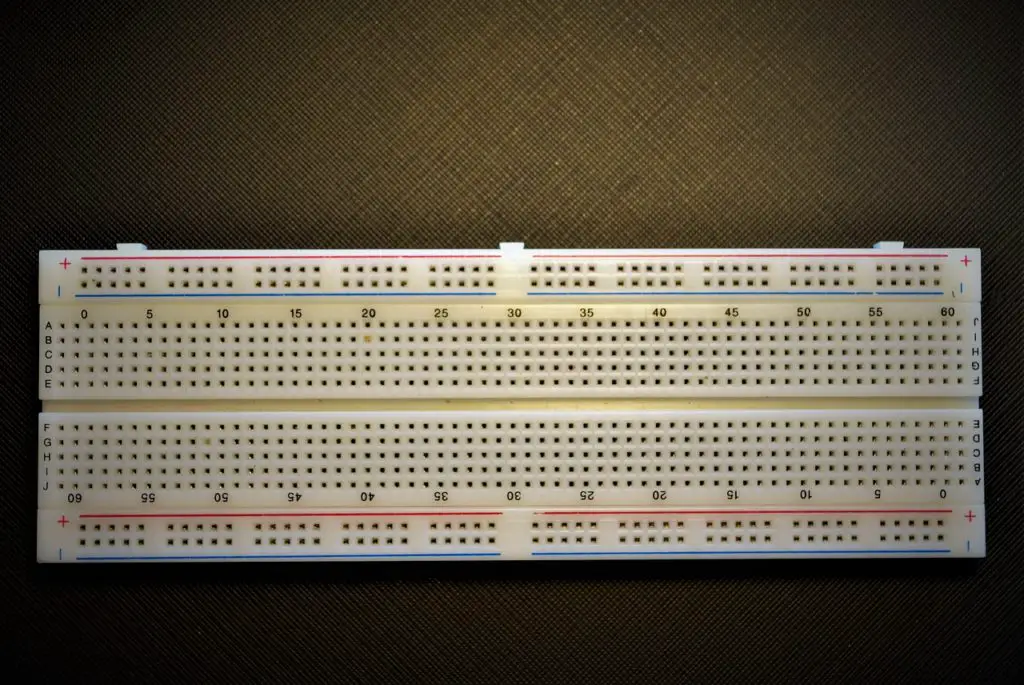
As you can see in the picture above, the breadboard consists of many holes where you can connect components into.
But, these holes aren’t all connected. There is a certain pattern to how they are connected.
The breadboard can be further broken up into sections which include;
- Terminal strips
- Power rails and
- DIP (Dual Inline Package) support
These three parts are highlighted in the image below.

Breadboard terminal strips
The terminal strips of the breadboard are where you connect and set up all the components of your circuit.
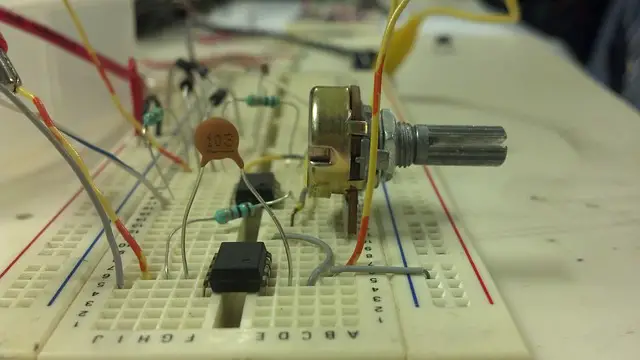
If we were to open up the breadboard and look inside (and view the breadboard sitting horizontally), we would see that the terminal strips have metal strips below them which are aligned vertically across the length of the breadboard.
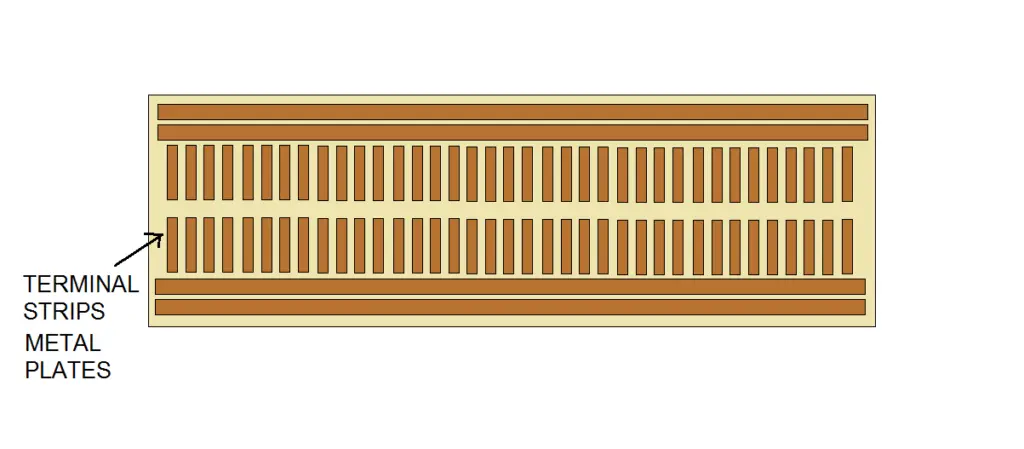
Furthermore, each hole in the row has a metal clip that helps hold the terminal of components securely.
So, a row of holes in the middle of the breadboard are electrically connected.
However, the terminal strips are separated into two halves by the DIP support.
Power rails of the breadboard
The next major part of the breadboard is the power rails.
The power rails of a breadboard are where you connect the supply voltage to (which could be a set of batteries, or a power supply).
Other components can then access these positive and negative rails as needed.
Again, if we opened up the breadboard and had a look inside (with the breadboard sitting horizontally), we would see a set of metal strips that run horizontally the length of the breadboard from one end to other.
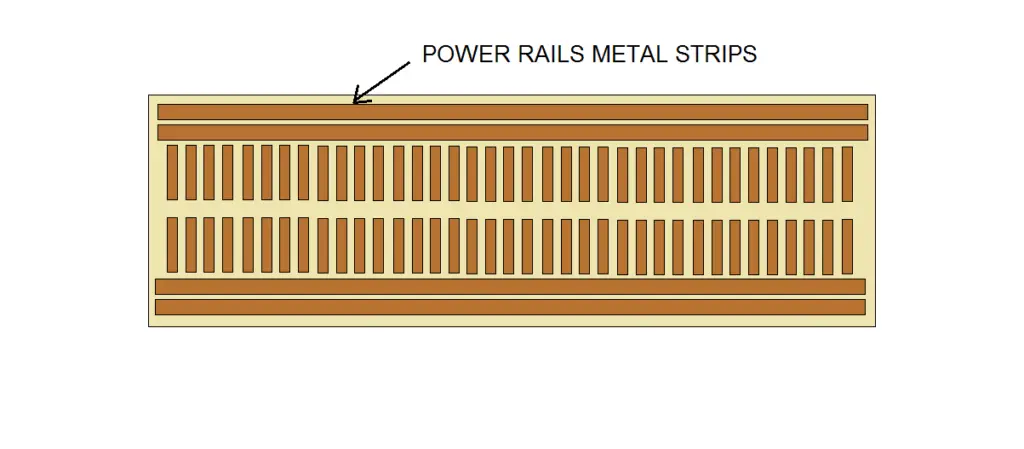
So, why is it not advisable to cut a breadboard?
As you saw, the breadboard is constructed specifically with metal strips and holes so that you connect components and wires easily.
Cutting a breadboard is going to ruin the structural integrity of the breadboard which might render the breadboard useless.
The metal strips might come out of place or be damaged in the process of cutting. These metal strips are crucial as they are needed to create a conducting path for current.
Also, the metal clips that are under each hole which are used to hold component leads might get misaligned (or damaged) make it harder for you to place components.
How to cut a breadboard, if you really have to
But, what if you have to cut your breadboard?
Is there a special way to do so without causing too much damage and still being able to use the breadboard as it is intended to?
There are couple considerations to take into account if you are about to cut a breadboard;
- The cutting tool you are using and
- The direction of the cut
The best cutting tool to cut a breadboard
You will need to use a cutting tool that does not create a mess of your breadboard.
Using a hand saw or jigsaw, might not be the best option for cutting tools as they do no provide the cleanest of cuts.
A better option could be a Dremel, which provides a better finish and might cause less damage to the breadboard when cutting it.
The best way to cut a breadboard
Next is the direction you cut the breadboard.
As we saw earlier, when looking at the breadboard horizontally, the metal plates of the terminal strips are aligned vertically, while the metal plates of the power rails are aligned horizontally.
The best way to cut a breadboard, while still maintaining its structural integrity is vertically down the middle (when the breadboard is sitting horizontally) as depicted in the picture below with the red line.

If you cut a breadboard horizontally (when it is placed horizontally), due to the way the metal plates are orientated, you are going to eliminate one half of the breadboard and reduce the surface area of the breadboard giving you less space to set up circuits.
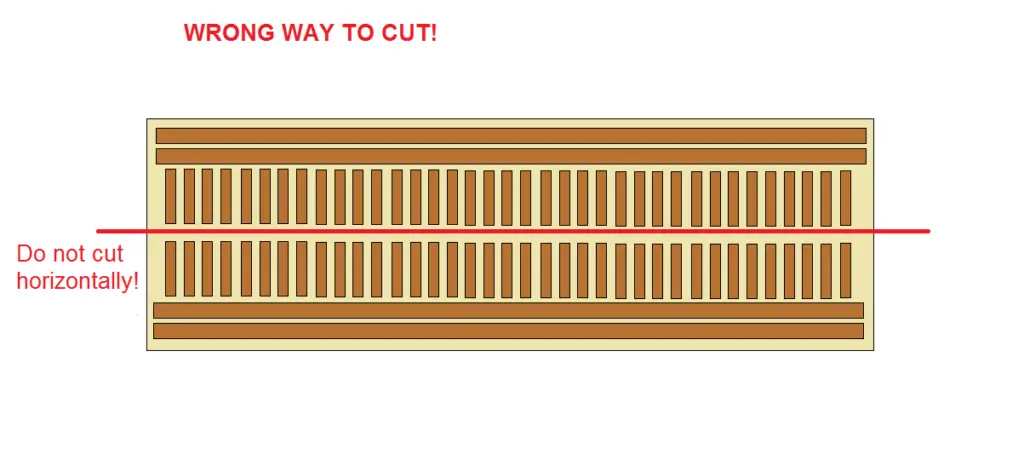
As well having less area to set up circuits, you are going to eliminate the middle gap (DIP support) which is designed as a support for Integrated circuits.
Checking your breadboard is working. In case you cut it!
So you have cut your breadboard!
How do you check if it is working?
The first thing is to make sure that it is still intact and hasn’t come apart entirely.
If it has fallen apart, the easiest way to check if a breadboard that has been cut is still working, is to set up a circuit.
It does not have to be a complex circuit, a simple circuit should do just fine (as long as it tests all the sections of the breadboard; terminal strip and power rails.)
Connect your circuit and power it.
If everything is working as it should, you have cut your breadboard without any problems.
Another way to test if the breadboard is still working is to use a multimeter and its Continuity function (which is a test to check if two points are connected electrically).
Using this function of the multimeter, you could test the ends of each terminal strip and power rail to ensure they are still electrically connected and not damaged.
An alternative to cutting your breadboard?
If the main reason for you cutting your breadboard is to reduce its size, you have another option.
Buying a smaller one!
Breadboards come in a variety of sizes which you should be able to choose accordingly to meet your project/application needs.
Can you break a breadboard?
No, do not attempt to break a breadboard in half using your hands.
This is definitely not a good idea.

